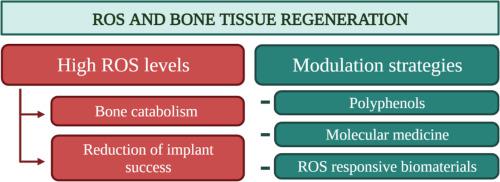Biomaterials Advances ( IF 7.9 ) Pub Date : 2021-09-16 , DOI: 10.1016/j.msec.2021.112433 Giorgia Cerqueni 1 , Annachiara Scalzone 2 , Caterina Licini 3 , Piergiorgio Gentile 2 , Monica Mattioli-Belmonte 1

|
The presence of Reactive Oxygen Species (ROS) in bone can influence resident cells behaviour as well as the extra-cellular matrix composition and the tissue architecture. Aging, in addition to excessive overloads, unbalanced diet, smoking, predisposing genetic factors, lead to an increase of ROS and, if it is accompanied with an inappropriate production of scavengers, promotes the generation of oxidative stress that encourages bone catabolism. Furthermore, bone injuries can be triggered by numerous events such as road and sports accidents or tumour resection. Although bone tissue possesses a well-known repair and regeneration capacity, these mechanisms are inefficient in repairing large size defects and bone grafts are often necessary. ROS play a fundamental role in response after the implant introduction and can influence its success. This review provides insights on the mechanisms of oxidative stress generated by an implant in vivo and suitable ways for its modulation. The local delivery of active molecules, such as polyphenols, enhanced bone biomaterial integration evidencing that the management of the oxidative stress is a target for the effectiveness of an implant. Polyphenols have been widely used in medicine for cardiovascular, neurodegenerative, bone disorders and cancer, thanks to their antioxidant and anti-inflammatory properties. In addition, the perspective of new smart biomaterials and molecular medicine for the oxidative stress modulation in a programmable way, by the use of ROS responsive materials or by the targeting of selective molecular pathways involved in ROS generation, will be analysed and discussed critically.
中文翻译:

深入了解骨组织中的氧化应激和生物材料的新挑战
骨骼中活性氧 (ROS) 的存在会影响常驻细胞行为以及细胞外基质组成和组织结构。衰老,除了过度超负荷、饮食不均衡、吸烟、易感遗传因素,都会导致 ROS 增加,如果伴随着不适当的清除剂产生,则会促进氧化应激的产生,从而促进骨分解代谢。此外,许多事件都可能引发骨损伤,例如道路和运动事故或肿瘤切除术。尽管骨组织具有众所周知的修复和再生能力,但这些机制在修复大尺寸缺损方面效率低下,因此通常需要骨移植。ROS 在植入物引入后的反应中起着重要作用,并可以影响其成功。这篇综述提供了对体内植入物产生的氧化应激机制的见解及其调节的合适方法。活性分子(如多酚)的局部递送增强了骨生物材料的整合,证明氧化应激的管理是植入物有效性的目标。由于其抗氧化和抗炎特性,多酚已广泛用于治疗心血管、神经退行性疾病、骨骼疾病和癌症的药物中。此外,将批判性地分析和讨论通过使用 ROS 响应材料或靶向参与 ROS 生成的选择性分子途径,以可编程方式调节氧化应激的新型智能生物材料和分子医学的前景。



























 京公网安备 11010802027423号
京公网安备 11010802027423号